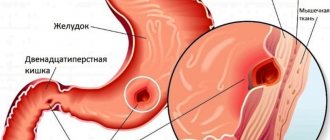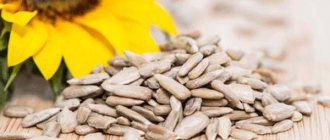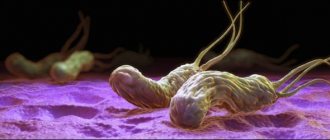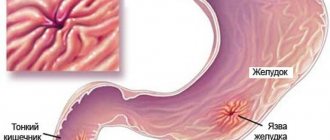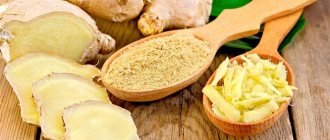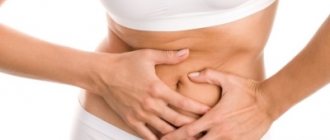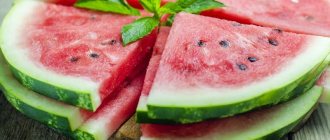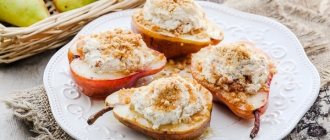Share information with your Facebook friends
VK
For diseases of the digestive organs, a diet is first prescribed. This is a very effective treatment method. And they cannot be neglected. At the same time, it is worth knowing that a new diet is your new lifestyle, which you must always adhere to. After all, returning to your usual diet will again lead to digestive problems. But you shouldn’t take a new diet as punishment. You can always find food that will satisfy your taste needs and be safe for your stomach.
General rules. Duration of the diet.
In case of exacerbation of the disease, you should adhere to diet No. 1. And when the symptoms subside, you can switch to diet No. 5
Nutrition for stomach and duodenal ulcers consists of several important rules:
- A certain way of preparing food. Food can be baked without crust, boiled, or stewed.
- The number of meals should be at least 5-6 times a day. The volume of food is no more than 200 ml per meal.
- Food should be warm (32-38 C), not hot or cold.
- Dishes must be nutritious and balanced in nutrients.
- Drinking regime. The amount of fluid you drink per day should be at least 2 liters of fluid.
- You should not eat food that irritates the mucous membrane, as well as carbonated drinks.
- Minimize the amount of salt you consume
The diet must be followed even in case of long-term remission. Any dietary disturbances can lead to exacerbation of the disease and the development of complications.
How to eat after surgery?
In case of an advanced ulcerative process, perforation of an ulcer into the abdominal cavity with the development of peritonitis, or suspicion of malignancy (degeneration into a cancerous tumor), doctors offer surgical treatment. It consists of a larger or smaller volume of removal of the stomach (resection) and the connection of the remaining stump with the intestine.
It is clear that after the operation the stomach will no longer be able to perform the functions of a healthy organ. Food will quickly enter the small intestine insufficiently digested. One of the expected complications is dumping syndrome. To help prevent it, you need to follow a diet.
Maximum preservation of functioning tissues in case of an ulcer of the greater curvature is ensured by a longitudinal variant of gastric resection
Features of the diet after gastrectomy are added to the requirements already listed:
- limiting foods with “light” carbohydrates that are quickly absorbed (sweets, adding sugar and honey to tea, milk porridge);
- reducing the volume of a single food intake so as not to overload the remaining part of the stomach: you can drink no more than 200 ml of kefir or compote at one time, drinks after other dishes cannot be drunk immediately, you need to wait from 30 to 60 minutes;
- You should take diet most seriously in the first 2–3 months after surgery; the digestive system needs this period to adapt to new conditions.
The diet therapy regimen includes no food and limited drinking on the first day. From the second day of appointment in accordance with dietary table No. 1a. Kissel and porridge without added sugar. From the tenth day, switch to diet No. 1b with limited carbohydrates, then table No. 1. Puréed food remains on the menu for the first 2–3 months. Then it is possible to switch to the “unprocessed” option.
After 3–4 months of postoperative period, the patient is allowed to switch to dietary table No. 5 and will have to fulfill its requirements for the rest of his life. It provides a wider range of products than table No. 1 due to vegetables and fruits, salads, pasta, and cereals. But there remain requirements for culinary processing, limiting animal fats, banning salty foods, seasonings, and frying technology.
Vegetables for the first course are first boiled, then mashed or crushed in a blender and returned to the soup
Nutrition for ulcers during exacerbation:
During the period of exacerbation of the disease, it is necessary to follow a strict diet. Food should have enveloping properties. Dishes are best boiled or steamed. Food should be ground to a paste or served as a puree. The number of meals should be increased.
Notice!
An ulcer during an exacerbation is a contraindication for sanatorium treatment: it is better to go to a hospital.
If you have a chronic
form, then you should regularly
carry out preventive treatment
.
Stomach ulcer
Stomach ulcer is a serious disease. With such an illness, internal bleeding can occur and even cancer can develop. The main cause of ulcers is considered to be a violation of the protective properties of the gastric mucosa. Modern medicine believes that the vital activity of the microorganism Helicobacter pylori underlies this disorder. Provoking factors can be poor quality food, namely heavy, spicy, too fatty foods, frequent consumption of fast food and other harmful factors such as stress, taking certain medications, endocrine diseases.
Symptoms of a stomach ulcer:
- Pain in the stomach, discomfort. Especially after eating.
- Heartburn, belching.
- Heaviness, nausea.
If the disease is confirmed, the doctor prescribes drug treatment, most often antibiotics and drugs that inhibit the secretion of stomach acid. A diet is always prescribed for such a disease. Without proper nutrition, it is practically impossible to cope with this disease.
If the patient's ulcer is in the acute stage or there are other concomitant health problems, the doctor adjusts the treatment.
Nutrition for chronic peptic ulcer disease:
In case of peptic ulcer, proper nutrition is a fundamental condition for recovery and stable remission.
The diet should be selected by the attending physician, taking into account individual characteristics, concomitant diseases, stage of the disease, age and body weight of the patient.
For all patients suffering from peptic ulcer disease in remission, certain rules are followed when compiling a menu:
- Complete exclusion from the diet of foods that irritate the mucous membrane.
- Fractional meals 5-6 times a day in small portions
- Last meal 2 hours before bedtime. You can drink warm milk before going to bed
- In case of stable and long-term remission, a transition to zigzag nutrition is possible under the supervision of the attending physician.
Nutrition after surgery:
- In the early postoperative period, it is necessary to follow a special diet. To adapt the stomach, you should not eat for the first three days after surgery.
- On days 4 and 5, doctors allow you to drink sweetened herbal tea and berry jelly.
- In the future, the diet can be expanded. You can eat vegetable soups in the form of puree, cereal milk porridges.
FAQ
Is it possible to drink lactic acid drinks (kefir, fermented baked milk, yogurt) if you have an ulcer?
During the period of exacerbation of the disease, kefir and fermented baked milk are prohibited. In addition, in the next 5 days after the attack has stopped, you should also refrain from drinking these drinks, so as not to provoke a relapse of the pathology. Subsequently, they can be gradually introduced into the diet, from small doses (from 50 milliliters).
The main condition is that kefir and fermented baked milk should be fresh, moderately sour, with a minimum fat content. Before drinking, drinks are slightly warmed. To speed up the scarring of the ulcer, add a teaspoon of vegetable oil.
Yogurt is a priority food product for stomach diseases, since it contains bifidobacteria that inhibit the effect of Helicobacter Pylori.
Is it possible to eat cucumbers and tomatoes?
If you have a peptic ulcer, you should avoid eating tomatoes, as they reduce the rate of healing of ulcers and increase the acidity of gastric juice. As a last resort, tomato fruits can be eaten after preliminary heat treatment with boiling water, removing the skin. Cucumbers are contraindicated during the period of exacerbation of the disease, however, during the remission stage, it is allowed to include half a vegetable per day in the patient’s diet - without the skin, in crushed form.
Can you eat bananas?
Judgment about this fruit is contradictory. Nutritionists have different opinions regarding the inclusion of bananas in the diet of a patient with damage to the gastric mucosa. Some claim that it reduces the acidity of gastric juice, eliminates pain, and heals ulcers. Others are convinced that bananas are “heavy” foods that burden the digestive tract and take a long time to digest, which is unacceptable for ulcers.
Is it possible to eat cottage cheese and cheese?
Yes, these are valuable foods for a person with an ulcer. Cottage cheese is a coagulated milk protein that supplies iron, retinol, niacin, and B vitamins to the body. There is no whey in it. It is worth choosing cottage cheese with a minimum percentage of fat content. The product can be used to prepare soufflés, mousses, creams, and casseroles.
Cheese is a storehouse of amino acids, calcium, and easily digestible protein. This is an alternative to meat products. When choosing hard cheeses, give preference to a product with low salt and fat content.
Can I have eggs?
Yes, provided they are cooked soft-boiled. Hard-boiled or fried eggs should not be consumed by patients with stomach ulcers. You should avoid taking the product in its raw form, as it increases the risk of contracting salmonellosis.
Egg white is well absorbed by the human body, and the yolk supplies nutrients: calcium, cobalt, iron, phosphorus, vitamins A, , , , .
Can I have watermelon?
No, it contains coarse fiber, which stimulates the production of gastric juice, increases its acidity, and aggravates the course of the disease.
Can I have seeds?
No, they irritate the gastric mucosa and can mechanically injure it, which threatens to aggravate the pathological process. In addition, seeds contain difficult-to-digest fats. As a result, after the nuclei enter the stomach, the patient feels discomfort in the epigastric region, flatulence and pain occur, the acidity level increases, and the ulcerative process worsens.
Can I have garlic?
This product is strictly prohibited; it cannot be consumed in its pure form or as part of prepared dishes, since it has a pungent taste that irritates the gastric mucosa, increases pain, provokes a relapse of the disease (during remission), a sharp deterioration in the patient’s condition (during acute stage).
Can I have coffee?
No, the drink increases the production of hydrochloric acid, which accelerates the development of the disease. During stable remission, natural brewed coffee can be consumed in moderation (up to 50 milliliters at a time), with weak, half-diluted milk.
Can I drink soda?
The most common symptoms of ulcers are belching and heartburn. To relieve discomfort and relieve the first symptoms, many people use soda. However, not every one of them thinks about whether it is safe and what it can lead to?
The substance actually neutralizes hydrochloric acid, which is formed in excess quantities during stomach diseases. It is worth considering the fact that the soda solution brings relief for a short period of time.
Within 0.5 - 1.5 hours, when it leaves the organ, the body will release a new portion of acid in increased quantities. Which will lead to increased stress on the stomach. In addition, when it reacts with soda, carbon dioxide is released, which puts increased pressure on the walls of the stomach. As a result, the risk of perforation increases at the sites where ulcers form.
If you have a stomach ulcer, you should not drink soda in any quantity.
Why should you not drink strong alcoholic drinks?
This is justified by the fact that ethyl alcohol causes inflammation of the stomach walls, slows down the digestion of food, increases the acidity of gastric juice, which as a result aggravates the pathological process, and increases the risk of gastric bleeding. Alcoholic drinks can be consumed up to 100 milliliters every 2-4 days, when there is no exacerbation of the disease. At the same time, the day before you need to eat a hearty meal of gentle food that envelops the stomach. This is the only way to protect the walls of the organ from the aggressive effects of a strong cocktail.
Is it possible to smoke?
Absolutely forbidden. Tobacco smoke has a stimulating effect on the digestive tract; nicotine inhibits the regeneration process, increases existing inflammation, and provokes belching, heartburn, and pain.
According to statistics, smokers die from stomach ulcers 5 times more often than people without a bad habit.
List of permitted products:
| Lean meats | Idea, chicken, veal, rabbit |
| fish | Low-fat varieties of fish, preferably river or lake fish |
| Bread and pastries | It is acceptable to eat wheat bread that is a day old. Unsweetened cookies, crackers without additives, sponge cake. |
| Dairy | Lenten cheese, low-fat cottage cheese, yogurt and fermented baked milk |
| Vegetables | Carrots, potatoes, cauliflower, zucchini, pumpkin, boiled greens |
| Fruits | Apples and pears, peeled and baked |
| Cereals in the form of porridges | Buckwheat, oatmeal, semolina, rice |
Cooking and eating
Acceptable cooking methods: boiling, steaming, baking without crust. Ready-made food can be pureed or finely chopped; fish and meat can be eaten in pieces. Regularity of administration – 4-5 times a day, at the same hours. It is necessary to exclude very hot and cold foods.
Allowed
Drinks: weak tea or cocoa, including with milk
Bread products: day-old white wheat bread, white crackers, soft biscuits or biscuits Snacks: mild cheese, low-fat and unsalted ham, salads from boiled vegetables, meat and fish, doctor's, dairy and diet sausages
Milk and dairy products: whole milk, dry or condensed milk, cream, fresh grated cottage cheese Fats: unsalted butter, refined vegetable oils for ready-made dishes Eggs: soft-boiled, steamed omelet, no more than 2 pieces per day
Soups: from pureed cereals, puree soup from boiled vegetables (except cabbage) with a decoction of cereals and permitted vegetables, milk soup with small noodles. You can add milk, cream, egg to soups
Vegetables: potatoes, carrots, beets, cauliflower, early pumpkin and zucchini, limited green peas, finely chopped dill in soups
Meat and fish dishes: lean beef, veal, chicken, rabbit, turkey. Types of fish: pike perch, carp, perch.
Prepared in the form of steam cutlets, soufflés, purees, zraz, quenelles, soft varieties are boiled in pieces
Cereals: semolina, rice, buckwheat, oatmeal, boiled in milk or water. Small vermicelli or pasta Fruits, berries, sweets: sweet varieties of ripe fruits, berries in the form of compotes, jelly, mousse, jelly, baked, sugar, jam, marshmallows, marshmallows
Juices: raw from permitted vegetables, sweet berries and fruits, rosehip decoction
Must be excluded
Broths - meat, fish and strong vegetables, mushrooms, fatty meats and fish, pickles, smoked meats, marinades, canned food, butter dough, pies, black bread, raw unprocessed vegetables and fruits, ice cream, kvass, coffee, carbonated drinks, chocolate, sauces, except milk sauce, white cabbage, turnips, radishes, sorrel, spinach, onions, cucumbers.
If the patient has a severe exacerbation with prolonged pain, then in the first 7-8 days of treatment, food is prescribed with great restrictions: bread, any vegetables, snacks are completely excluded, all dishes are only pureed.
Download or print:
Diet No. 1
Make an appointment Do not self-medicate. Contact our specialists who will correctly diagnose and prescribe treatment.
List of fully or partially restricted products:
| Foods rich in coarse fiber | Mushrooms, legumes, wholemeal bread, fresh bread, rye bread |
| Fatty meats | Pork, lamb, duck, goose, game |
| Spreads, cooking oil, margarine | Irritate the mucous membrane |
| Spicy and salty dishes | May lead to exacerbation of the disease |
| Sour and unripe fruits and berries | Oranges, tangerines, lemon, kiwi, currants, grapes |
| Dairy products | Whey, fatty fermented milk products and dairy products with high acidity |
Nutrition menu for peptic ulcer disease. Diet.
Proper nutrition for gastric and duodenal ulcers is the key to health and the possibility of long-term remission of the disease.
It is necessary to follow a daily diet:
- Fractional frequent meals
- Eating only warm food
- Portions should be small
- Reduce the amount of salt in dishes
- It is best to cook by steaming or boiling. Grind food
- Drink enough still water.
Recipes for dietary dishes for peptic ulcers:
Breakfast:
Buckwheat porridge with milk. Rose hip decoction.
Lunch:
steam omelette. Baked pear.
Dinner:
Vegetable soup with chicken meatballs. Mashed potatoes with boiled fish (pike perch). Herb tea
Afternoon snack:
low-fat yogurt. Galette cookies. Apple compote.
Dinner:
rabbit, potato and cauliflower casserole
Before bedtime
you can drink a glass (more than 200 ml.) of warm milk
Nutritionist comments:
Diet for peptic ulcers plays an important role in the treatment of ulcers. A properly composed menu makes it possible to eat tasty and healthy food, which will also be useful for the functioning of the entire digestive tract.
“The right choice of a sanatorium is a significant step towards maintaining and increasing health. “Gorny” is a resort complex that combines the experience and knowledge of Russian and Soviet balneology. The presence of modern medical equipment and innovative installations, the professionalism of the staff and love for their work will serve as the key to extending longevity,” - head doctor of the sanatorium Alexander Olegovich Karaulov.
